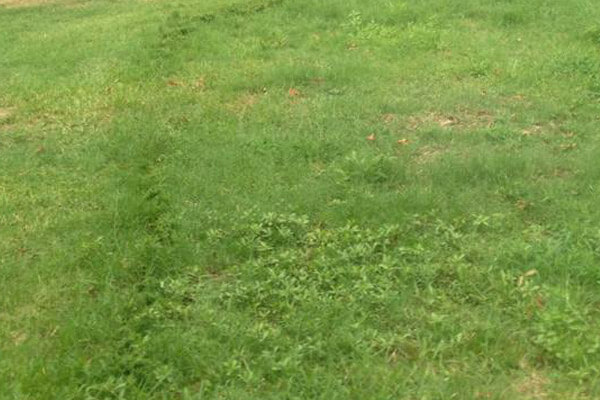
Winter Lawn Care Tips for a Better Spring
How to Prepare Your Lawn for Winter
You may think that as the weather starts to get colder that you can forget about all lawn maintenance until it warms back up in the spring. While it’s true that you don’t have to do nearly as much as you do in the summer, there are still some important lawn care tasks that demand your attention during the winter months. Read on to find out what you can do during the cooler weather to give your lawn a fighting chance in the spring.

Caring for Your Lawn, Trees and Bushes
Keep leaves, sticks, litter, and any other debris off your grass to allow it full access to the sunlight. If you shovel snow, do not create a large pile of it on your grass. Gently shake snow off of the leaves and branches of your outdoor plants and trees as well. Do not attempt to remove ice, however, as doing so may cause damage.

Keep It Mowed
Don’t store your mower in the shed quite yet. In cooler climates, you’ll need to mow until the end of fall, and possibly even several times in the beginning of winter before the first freeze. Those last few times, drop your mower’s blade to the lowest level to get your grass as short as possible without scalping it. If it’s too long, you may unwittingly be creating a haven for burrowing creatures seeking warmth during the winter. Also, long grass won’t allow air to circulate around it, especially under the weight of snow, and your lawn may contract snow mold, a disease which can cause irreparable damage. Also, don’t forget to clean, repair, and run routine maintenance on your mower before storing it away for several months.
Aerate
Aerating your lawn allows sun, oxygen, rain, and fertilizer to reach the roots of the grass. If you don’t own your own aerator, contact MIKO for an estimate. There are also manual ones available that will give you a good workout while you care for your lawn.

Fertilize
The best time to fertilize your lawn is in the fall and late fall, after aerating, but before the first freeze. Fertilizer provides valuable nutrients to your grass despite it being in a dormant state. MIKO Lawn & Landscape uses 100% all natural fertilizer for all its applications. It not only provides the required major nutrients your grass needs, but also several trace minerals necessary to grow strong healthy grass.
Fill In
If you have any bare patches in your yard, fill them in with grass seed, or the same species of sod you have in the remainder of your lawn.
Stay Off the Grass
When grass is short and brown, it’s best to stay off. Your lawn is in a somewhat vulnerable state during the cooler months, so after you’ve completed all the aforementioned tasks, try to stay off the grass as much as possible.
A little preparation goes a long way. Don’t neglect your lawn in the late fall or winter, and reap the rewards of your hard work and attention in the spring.

Love Gardening… Here’s A Few Tips for a Great Garden!
What are the essentials?
Gardening can be pure satisfaction when you gather the harvest all season long, or an endless challenge when plants don’t grow but the weeds do. It will take some time, sweat and work to get a garden prepared, but the rewards are generally well worth it.

Prep Your Garden for the Coming Spring
It’s time to remove the covers and “de-winter” your garden. As the seasons shift into spring, there’s plenty to do to make sure you’re fit for full-bloom – and these are the steps to get you there.
Arm Yourself
There are three essential tools when it comes to stacking the gardening-rack in your shed. No gardener worth his salt would be caught dead without any one of them:

A Spading Fork
Ah, the spading fork – the Excalibur of garden preparation! The spading fork is something like a short-handled pitch fork, and you can find one at any garden store (or outdoor department) around. Really though, if your garden store doesn’t sell spading forks – it’s not a garden store. So pick one up and go get yourself as deliciously dirty as possible!
A Rake
If you don’t already have a rake – stop reading this, get into your car, go out to the store and buy one immediately!
A Good Pair of Gardener’s Gloves
From planting and transplanting to turning, tilling and pulling – Gardener’s Gloves are the centerpiece of springtime armaments. Prices range from a couple bucks to a pretty hefty penny – but so do varieties!
Be mindful that you get what you pay for. Think of features you’re sure you’ll need (straps, Velcro, rubber palms, etc.).

Thicken the Plot
Your freshly turned soil is fit to breathe, but it needs recovery nutrients. “Soil Amendment” is the act of beefing up your plot. It’s time to add compost, fertilizer, vermiculite – or whatever other amendments may be called for. We conduct soil testing, an essential part of determining which nutrients your landscape needs and what product to apply. Prices range for what you would like tested but our recommended test is only $20 and covers organic matter, six key nutrients and pH.
Compost
Get creative with this one; add as many different types of compost as you can. Get your soil tested so we can pinpoint exactly what’s missing. Your soil will settle throughout the season, so it’s best to fill your beds to the top. Take it slowly if you’re unsure of the amount of compost to buy. Do a few beds at once (up to half), to better gauge your compost-needs.
Fertilizer
Now add a complete fertilizer to your garden bed and mix it into the top 6-9 inches of soil. Use a slow-release fertilizer, which ensures nutrients continue to suffuse your garden without having to re-fertilize in later months. Here at MIKO, we offer all natural fertilizers perfect for any garden’s needs. Call us for details. There are plenty of resources if you have specific questions about fertilizers (ratios, mixes, etc.).
Vermiculite
Throw in some vermiculite – especially if your garden’s soil is heavy and overly-moist, and if it’s stuck together in large clumps upon turning it over. Vermiculite lightens the soil significantly, drawing and containing air and water into the pockets it creates.

Raise Your Supports
A lot of plants and vegetables are more inclined to grow higher as opposed to wider. Grab some refills or some first-time supports to structure your plots for the coming growth.
Bamboo Stakes
It’s time to organize and set your garden stakes. Stakes come in different styles, materials, and lengths – and you’re the only one who knows exactly which ones to use.
Trellis Netting
Trellis netting should probably be replaced every 2-3 years, depending on the care you give to removing your plants.
Plan for Irrigation and Planting
It’s probably not a good idea to turn on your irrigation just yet – as there may still be risk of a freeze. Either way though, it’s the perfect time to set out your grids and irrigation, so you can avoid having to place them around and over plants once they’ve begun to grow.
Gather Your Seeds
There’s no real need (unless your plants are exceedingly large) to purchase more than one or two packets per plant – and that’s with leftovers to store for next year. And there you have it! Spring is finally here again, winter is ending, and new growth is upon us! Your garden beds should be well-prepped by now – so here’s to a healthy bloom!
Photo Credits: Albright Design Studio; Nic McPhee, Jason, mystuart, Kyle. via Flickr.
Back to Main Home Page for Miko Lawn and Landscape / Moma Tree and Lawn Care

